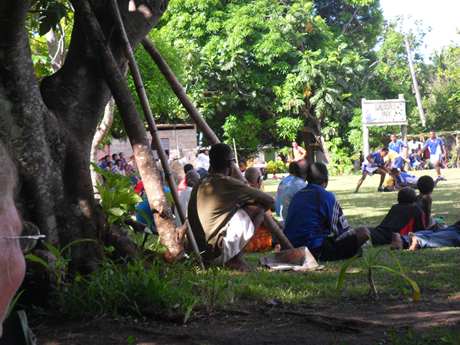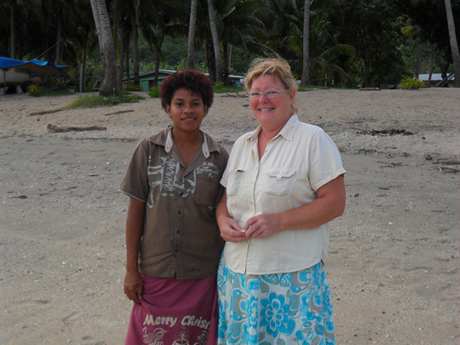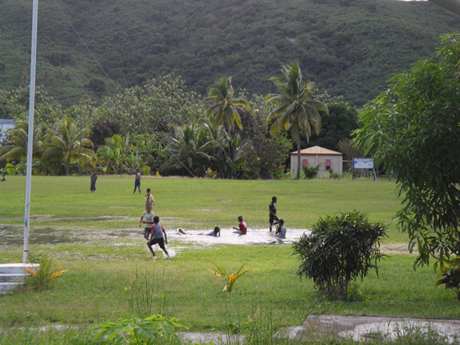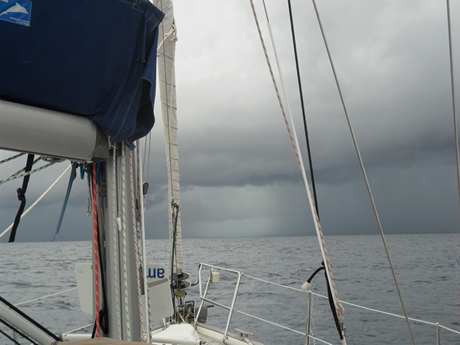Fiji - The Yasawa Islands

|
Having received our cruising permit we visited immigration and customs again and were given our clearance from Savusavu with the condition that we followed an agreed set route and visited Lautoka cutsoms once we arrived there. The weather remained very changeable. We continued eastwards along the coast to a small ferry port which had little to recommend it, so once we had had a rest we continued overnight across Bligh Water, a large inland sea that is surrounded by reefs, but over 300 metres deep and up to 50 miles across. This allowed us to arrive in the Yasawa Islands in daylight continuing southwards and dodging reefs as we went. The first possible stop was at a large bay surrounded by island but we could find no water shallow enough to anchor so we continued on and finally anchored in the romantic sounding Blue Lagoon. This lagoon fronts the very exclusive Turtle Island Resort, which extends all down one side of the bay. Unfortunately the weather was grey and we found ourselves downwind of a noisy generator at a dive centre almost at the head of the bay. A little further back there was an attractive stretch of beach but with large unfriendly notices warning us to keep out of the Turtle Island Resort. Consequently we did and the following morning left early with a seaplane buzzing over our head to land some guests at the resort. Although the weather continued to deteriorate, we were luckier with our next stop at the village of Somosomo. We wanted to anchor in a little bay near the village so that we would be able to snorkel on a WW2 aeroplane sunk just off the shore. In order to do this we had to go and do 'sevusevu' with the village chief, offering yaqona for making Kava. We duly went ashore but to our surprise found most of the villagers and many from neighbouring villages were watching a sevens rugby tournament. Consequently the chief, a woman in this case, was busy so a local man took our offering and said he would pass it on to her. We were taken on a village tour by one of his grandsons, it was remarkably large with a big village field in the middle complete with rugby posts. Rugby is their national game and every village has posts on their field. We then proceeded to join this group of ladies under the shade of the trees to watch the rugby and to eat some delicious reef fish (grouper we think) with cassava and lollo – a green sweet cabbage like vegetable. This was followed by a bowl of tea served with two soup spoons and cakes from one of the stalls.
The rugby was of a good standard. How they managed to play in the humidity and heat we do not know.
The men sat separately from the women and each group gathering represented a different village or island. We sat with the women from Savusavu who had married men from Somosomo so they had split loyalties to the teams but certainly seemed to support Savusavu more wholeheartedly. There was lots of shouting and shrieking, they do not have television in the small islands so this rugby tournament was a really major event in the calendar.
The locals, as everywhere in these islands, were incredibly friendly in a very un-intrusive way. If we talked to anyone they were interested in us and wanted to know where we were from and where we were going, but they absorbed us into the scene as if we were just another pair of locals.
This lovely lady, like a few other islanders, had
naturally red hair much like some of the people from
Senegal.
An action shot from the rugby....note the bamboo goal posts and stray chicken. What is not visible in this picture is that one part of the pitch had standing water in what was almost a pond, making an additional hazard not usually found at Twickenham!
We left before the final but it looked as if the Somosomo team had a good chance of making it.
We moved to the bay where we hoped we would be able to access the snorkel site. It got rather swelly and roly so a stern anchor was laid but overnight we had a nerve racking time as the wind blew hard into the bay. With a reef only a 100 metres or so from our stern we found it hard to sleep as vicious squalls came through. Our anchors were dug in well and we did not move. However, we were reluctant to leave the boat to go snorkelling so left in the morning in conditions which were far from ideal, the visibility was poor with plenty of cloud cover. These waters are notorious for uncharted reefs. Many of the charts have not been resurveyed since the British were here and some of them are based on 19th century surveys. Although we have 2 different forms of electronic charts these are still based on these same antique surveys. What you need in coral waters is a high sun. The reefs then show up clearly, especially if wearing polaroid sunglasses. Climbing the mast also allows for a better view. But none of this helps if the sky is overcast and the sea a uniform grey. Fortunately our charts turned out to be accurate enough and we anchored mid afternoon in another bay on the same island at Soso. It proved better than its name. We went ashore to give our yaqona again and this time the sevusevu ceremony was taken very seriously. We were taken to the chief, who was in his late 80s sitting on mats and rugs with his wife and grand daughter. We were asked to sit down with them in his living room whilst a local man chanted a blessing which we clapped to 3 or 4 times. We then asked that we should be allowed to anchor and swim in the village waters and permission was granted. His grand daughter then gave us an interesting tour of this tidy village. It was rather superior to Somosomo in that it had electricity, although that night there was no evidence of any lights....this from a village of about 500 people.
Lorraine and the chief's 19 year old grand daughter.
Another waterlogged rugby pitch at Soso. The children love this and use it like a paddling pool making long dives over the waterlogged grass into the middle, there didn't seem to be a mosquito problem, not then anyway.
The rainy season here goes on from November to the end of April but it is certainly overlapping into May this year as there has been plenty of rain. In Soso we literally paddled over the grass to see the school, we were ankle deep.
Some rules for the school children........ we particularly liked number 4
….........and some of the customers.
The remarkable thing about these villages is that they are quite difficult to see from seaward as they nestle between the coconut trees, the mangos and the breadfruit trees that are scattered throughout. At the same time some seem to have very little farmland as was obvious in this village that we sailed past, the white specks of houses are just visible.
Sadly one of our abiding memories of these islands will be the weather. We have been stuck near a convergence zone that has produced occasional squalls, some thunder and lightening, high humidity and little sun.
Not a reef to be seen!
|









